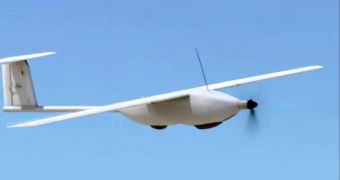Robots and drones aren't something we usually write about, but that only makes this month (July 2012) all the more interesting, if we do say so ourselves.
It wasn't too long ago that we covered the Samarai maple seed-shaped flying surveillance machine with a spinning camera.
Not two days later, a mind-controllable robot appeared and, now, another drone has caught our attention, one from Lockheed Martin.
At first glance, the so-called Stalker drone does not appear to be all that special, not in terms of shape (airplane), functionality or purpose.
As drones are meant to, it goes in the air and keeps an eye on the surroundings, usually recording things through a camera.
The reason this Stalker stood out this time is the time it managed to stay airborne: 48 hours, two days as it were.
And it wasn't because of any super batteries, but because of a maser power beam that kept sending it energy from the ground.
The test may not have been the last done in a wind tunnel as it was, but a field test is upcoming, when the Stalker will soar in the sky, to see if the laser solution holds up.
Speaking of which, the only reason the drone came down after 48 hours was the decision of the staff to bring the test to a close. Theoretically, the amount of air time should be unlimited, provided the drone stays within laser range and doesn't suffer defects.
Lockheed Martin hopes to score contracts with the military. Ways to scout the area without endangering soldiers are always sought after, especially when no sleep or breaks are needed, day and night.
Special Operations troops will probably reap the most benefits from something like this, assuming the thing isn't too noisy, but that shouldn't be a problem once the drone is at a certain altitude.
“We’re pleased with the results of this test. Laser power holds real promise in extending the capabilities of Stalker,” said Tom Koonce, Lockheed Martin Skunk Works Stalker program manager. “A ground-to-air recharging system like this allows us to provide practically unlimited flight endurance to extend and expand the mission profiles that the Stalker vehicle can fulfill.”

 14 DAY TRIAL //
14 DAY TRIAL // 
